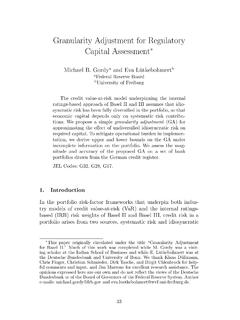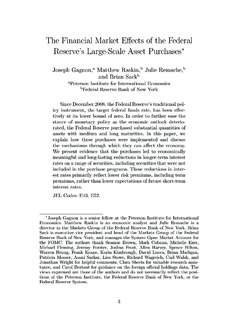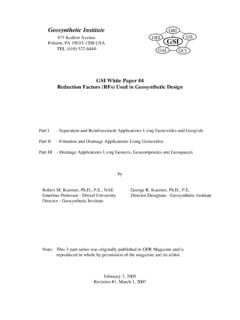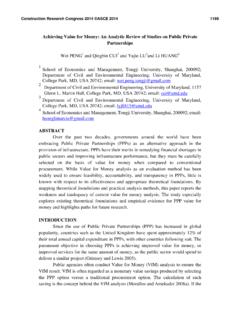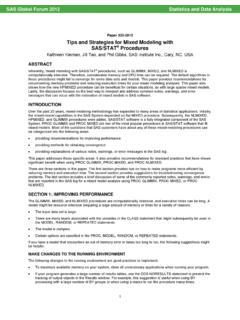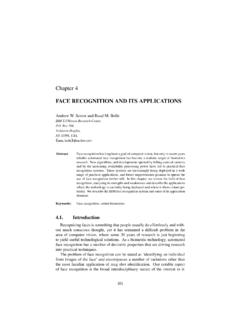Transcription of Macroeconomic Default Modeling and Stress Testing - IJCB
1 Macroeconomic Default Modeling and StressTesting Dietske Simons and Ferdinand RolwesDe Nederlandsche BankThis paper applies a Macroeconomic -based model for esti-mating probabilities of Default . The first part of the paperfocuses on the relation between Macroeconomic variables andthe Default behavior of Dutch firms. A convincing relation-ship with GDP growth and oil price and, to a lesser extent,the interest and exchange rate exists. The second part of thepaper assesses the Default behavior based on a Stress scenarioof two consecutive quarters of zero GDP growth as required bythe Basel II framework. It can be concluded that a Stress -testscenario covering two quarters of zero GDP growth does notinfluence the Default rate significantly and thus does not seemto be very Codes: C12, C13, C15, E32, E44, E47, G21, IntroductionEstimating probabilities of Default is the first step in assessing thecredit exposure and potential losses faced by financial of Default are also the basic inputs when evaluatingsystemic risk and Stress Testing financial systems.
2 Therefore, pre-dictors of credit risk are of natural interest to practitioners in thefinancial industry, as well as to regulators especially under the newcapital adequacy framework (Basel II), which encourages the activeinvolvement of banks in measuring the likelihood of defaults. The authors are grateful to Iman van Lelyveld and Maarten Gelderman andparticipants in workshops at the Sveriges Riksbank, Sweden. The views expressedin this paper are solely the responsibility of the authors and should not be inter-preted as reflecting the views of The Netherlands Bank. Corresponding author:Dietske Simons: Journal of Central BankingSeptember 2009 Financial literature has brought forth a variety of mod-els that attempt to measure the probability of Default , , Macroeconomic -variable-based models. Macroeconomic -based mod-els are motivated by the observation that Default rates in thefinancial, corporate, and household sectors increase during reces-sions.
3 This observation has led to the implementation of econo-metric models that attempt to explain Default indicators, suchas probabilities of Default or Default rates, using this paper we consider the Default rate in relation to macro-economic variables. Specifically, we will explore the relationshipbetween the Default rate and the macro economy by developinga logit model with Macroeconomic parameters. This fairly sim-plistic model has three advantages: First, the model is relativelyeasy to understand. Second, it presents robust results. Third, themodel takes the correlation of Default rates amongst sectors intoaccount. We call this special feature the correlation factor. Rela-tively little work has been done in previous research on estimatingsuch a correlation factor, although it has often been confirmedin the literature that Default rates are highly correlated direct consequence of this model and its advantages is thatthe direction of causality is only one way from macro variables todefault and that we do not allow for feedback from financial factorsto the macro variables.
4 We chose not to incorporate the banking sec-tor, in order to develop a relatively simple, easy-to-implement modeland focus solely on the relation between Macroeconomic variablesand the Default means of the logit model and selected variables, first we willassess which Macroeconomic variables are related to the defaultbehavior of firms and, second, examine the Default behavior in2007 on the basis of an unfavorable Macroeconomic scenario oftwo quarters of zero GDP growth in the third and fourth quar-ters of 2006. We will compare it with a base scenario and thesituation where we took the percent worst cases of the remainder of this paper is organized as follows. Section 2discusses related studies. Section 3 describes the construction ofthe data set. Section 4 formulates the estimation model. SectionVol. 5 No. 3 Macroeconomic Default Modeling1795 discusses the estimation results.
5 Section 6 studies the Stress -testscenarios. Section 7 The Concept of Macroeconomic -Based ModelsEstimating probabilities of Default is a challenging subject. Thetypes of models used to assess credit risk can be broadly classi-fied either as market-based models or as fundamental-based mod-els. Market-based models build on Merton s option-pricing theoryand rely on security prices. Chan-Lau (2006) distinguishes fourapproaches within fundamental-based Modeling to model proba-bilities of Default : Macroeconomic -based, accounting-based, rating-based, and hybrid models, as used in this research, explain changesin the Default rate on the basis of Macroeconomic Macroeconomic variables are cyclical indicators for instance,GDP growth or interest rates and financial market indicators for instance, stock market prices and stock market models, on the other hand, generate proba-bilities of Default for individual firms using accounting informa-tion.
6 Furthermore, rating-based models can be used to infer prob-abilities of Default when external ratings information is avail-able. Hybrid models generate probabilities of Default using acombination of economic variables, financial ratios, and (2006) lists three advantages of Macroeconomic mod-els. First, an advantage is that this type of model is very suitablefor designing Stress scenarios. Second, because long data series areavailable for most countries, it is also possible to conduct cross-country comparative studies. Third, the Default rate used to estimatethe model is observed historically, so that one can avoid the other hand, a disadvantage of Macroeconomic modelsis that the time span of the data needs to be longer than onebusiness cycle; otherwise, the model would not capture the impactof the business cycle on probabilities of Default . Furthermore, thistype of model is subject to Lucas critique since the parameters orfunctional forms are unlikely to remain stable; , it is virtuallyimpossible to capture the complex interaction between the state180 International Journal of Central BankingSeptember 2009of the economy and the Default risk.
7 Finally, aggregate economicdata are usually reported with substantial lags. This makes it diffi-cult to estimate or forecast Macroeconomic models with models can be classified into exogenous andendogenous models, depending on whether the model allows feed-back between financial distress and the explanatory economic vari-ables. The first category of Macroeconomic -based models assumesthat the economic variables are exogenous and not affected by finan-cial distress. The general approach to Modeling this category isdescribed by the following equation:pdt=g(x1,x2,..,xn)+ ,(1)wherepdis the probability of Default over a given periodt. A generalaggregate model setspdtequal to a functiong,X=(x1,x2,..,xn),a function of a set of economic variables and a randomvariable .A problem of the exogenous approach is that the relationshipbetween Macroeconomic variables and the Default rate is assumedto be the same during periods of economic downturn and seems intuitively to be second category of Macroeconomic -based models assumesthat the economic variables are endogenous and differ in times offinancial distress.
8 The typical econometric framework used in thesemodels is the vector autoregressive (VAR) methodology. See, forexample, Hoggarth, Logan, and Zicchino (2005). We can write theVAR in a more general form asZt+1= t+p j=1 jzt+1 j+ t+1,(2)where tis a constant vector, jare (lagged) coefficients matrices, t+1is a vector of residuals/shocks, andzis the vector of endoge-nous variables that includes both probabilities of Default and theaggregate economic variables associated with the state of the busi-ness cycle. In principle, inference in VAR models is sensitive to theVol. 5 No. 3 Macroeconomic Default Modeling181choice of lags. If a large number of lags is included, degrees of freedomare lost. If the lag length is too short, important lag dependenciesmay be end this section with a short overview of which macroeco-nomic variables are related to the Default rate. Appendix 1 lists anextensive set of papers on Macroeconomic Default Modeling , with ashort description of each.
9 It seems that the literature can be dividedinto that on quoted firms and that on unquoted firms. The papersmainly confirm the significance of GDP growth in relation to thedefault rate. Relations with stock market variables have been iden-tified several times, but only for the literature on quoted , some papers show that the influence of the interestrate and the exchange rate is significant in certain sectors. Remark-ably, none of the papers on our list examines the oil price as anexplanatory The Aggregate Default ModelingConsider a general aggregate model that can be estimated by max-imum likelihood. Letpdtbe the fraction (proportion) of firms thatdefault in periodt. We setpdtequal to a functiong(.) of the rele-vant explanatory variableszt, a parameter vector , and a distur-bance t. In addition, controlling the distribution of tcontrols thedistribution ( ,zt, t)(3)More specifically,pdt,iis the fraction of firms in sectori, i {0,1.}
10 ,s}that Default in periodt, withsthe total number of sec-tors in the economy. The economy as a whole is denoted byi= ,ztis a vector of variables including intercept, relevantfor the Default rate at timet. t,iis a disturbance and iis a vectorof ,i=exp z t i+vt,i 1 + exp z t i+vt,i (4)182 International Journal of Central BankingSeptember 2009 Taking the logit1of both sides, we find pdt,i: logit(pdt,i)=z t i+ t,i.(5)From this general model, we obtain two separate models, an economymodel (i= 0) and a sector model i {1,2,..,s}. For the economydefault rate (i= 0), we assume the disturbancesvt,0are indepen-dent and identically distributed ( ). Letting 2 ,0= var( t,0), theeconomy model is pdt,0=z t 0+ t,0where t,0iid 0, 2 ,0 .(6)For the sector Default rates, i {1,2,..,s}, the disturbancesare divided into a latent systematic ( t) and an idiosyncratic ( t,i)part. The systematic part captures the correlation between the sec-tor Default rates.




